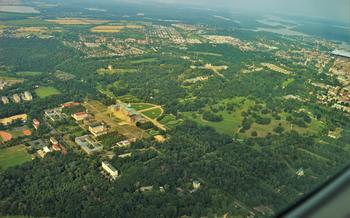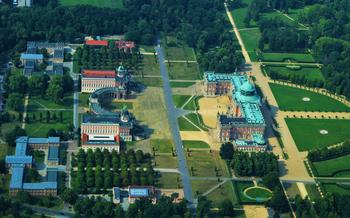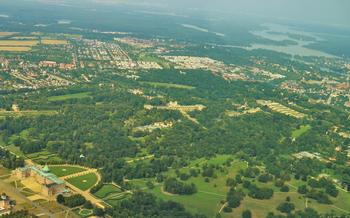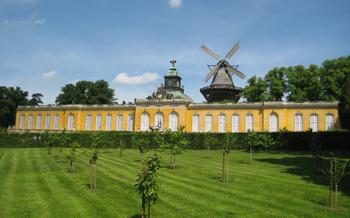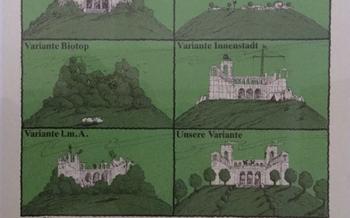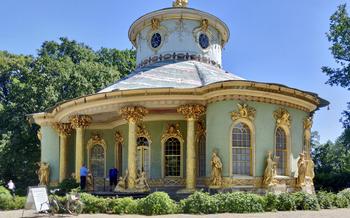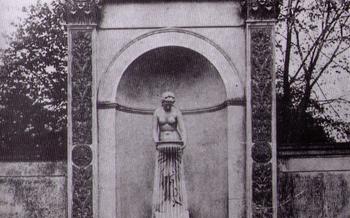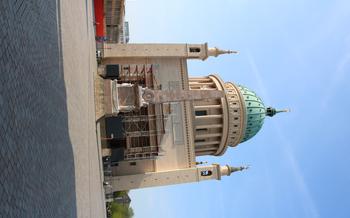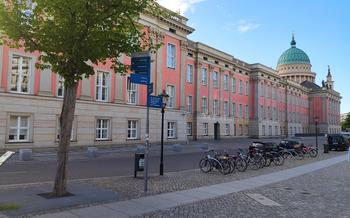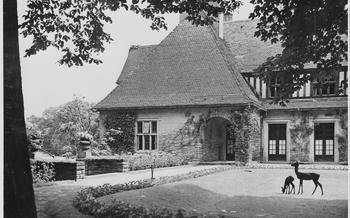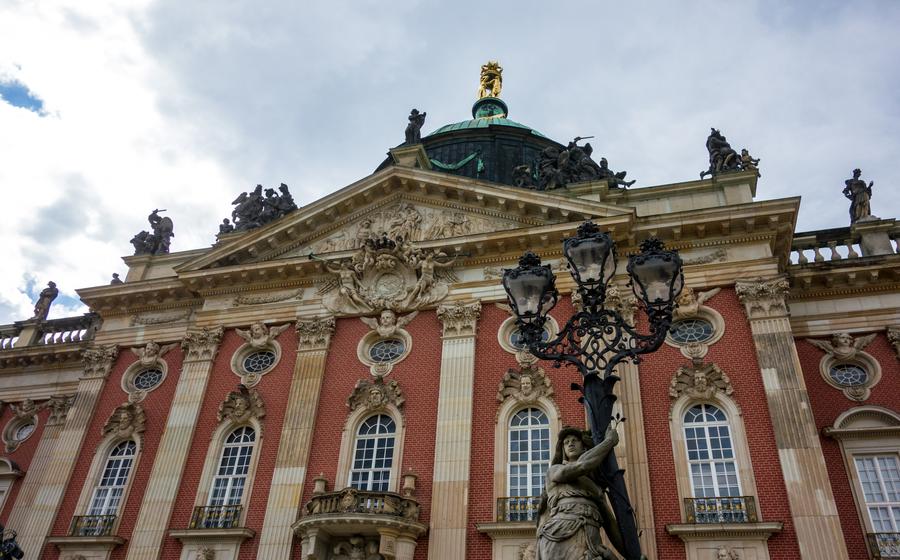
The New Palace (Neues Palais) in Potsdam
- History of the New Palace (Neues Palais)
- Architectural Highlights
- Interior Design and Decor
- Royal Apartments
- The Marble Hall
- The Voltaire Room
- The Picture Gallery
- The Orangery
- The Grotto
- The Gardens of the New Palace
- Guided Tours and Accessibility
- Events and Exhibitions
- Photography and Videography
- Food and Refreshments
- Insider Tips for a Memorable Visit
History of the New Palace (Neues Palais)
Constructed in the mid-18th century, the New Palace (Neues Palais) in Potsdam stands as a testament to the grandeur and opulence of the Prussian monarchy. Commissioned by King Frederick the Great of Prussia, the palace was built as a symbol of Prussia's growing power and prestige. Designed by the renowned architect Georg Wenzeslaus von Knobelsdorff, the New Palace showcases an exquisite blend of Baroque and Rococo architectural styles, reflecting the artistic sensibilities of the era. Initially intended as a summer residence for the Prussian court, the palace later served as a venue for lavish state functions, diplomatic events, and royal celebrations, embodying the grandeur of the Prussian monarchy.
Architectural Highlights
The New Palace boasts an exterior facade characterized by its grand scale and intricate details. The palace's main entrance, facing the gardens, is adorned with a majestic portico supported by imposing columns, creating a sense of grandeur and symmetry. The facade is embellished with intricate carvings, sculptures, and decorative elements, showcasing the Baroque and Rococo styles that were popular during the Prussian monarchy. The palace's wings extend symmetrically on either side of the central structure, creating a harmonious and balanced composition.
The palace's architecture seamlessly integrates with its surrounding gardens, creating a cohesive and picturesque landscape. The gardens were designed to complement the palace's grandeur, featuring intricate flower beds, manicured lawns, and meticulously placed sculptures. The integration of the palace and its gardens creates a sense of unity and harmony, enhancing the overall architectural experience.
Interior Design and Decor
The interiors of the New Palace are a testament to the opulence and grandeur of the Prussian monarchy. Elaborate design and lavish furnishings adorn every room, creating an atmosphere of luxury and sophistication. The palace boasts numerous chambers, each with its own unique character and purpose.
The Grand Gallery, the centerpiece of the palace, is a breathtaking sight. Its vast dimensions, intricate stuccowork, and gleaming chandeliers create a sense of awe and wonder. The gallery's walls are lined with an impressive collection of paintings, sculptures, and tapestries, showcasing the artistic patronage of the Prussian kings.
Symbolism and themes are woven throughout the palace's decor, reflecting the values and aspirations of the Hohenzollern dynasty. The sunburst motif, representing the radiance of the monarchy, is a recurring element in the palace's design. Allegorical paintings and sculptures glorify the virtues of courage, justice, and wisdom, reminding visitors of the moral foundation of Prussian rule.
The private apartments of the Prussian monarchs offer a glimpse into their personal lives. The royal bedrooms, with their rich tapestries and opulent furnishings, exude a sense of comfort and elegance. The dressing rooms and study areas reveal the monarchs' personal tastes and preferences, from their choice of clothing to their intellectual pursuits. These spaces provide a fascinating insight into the daily lives of the Prussian royal family.
Royal Apartments
The private living spaces of the Prussian monarchs at the New Palace are a testament to their opulent lifestyle. These apartments, located on the upper floors, provide a glimpse into the intimate world of the royal family. The royal bedrooms, with their luxurious furnishings, offer a sense of comfort and indulgence. The dressing rooms and study areas reflect the personal tastes and preferences of the monarchs, showcasing their lavish accessories and cherished possessions. The significance of the royal apartments lies in their embodiment of the monarchy's private life, providing insights into the daily routines and personal interests of the Prussian rulers.
The Marble Hall
The grandeur and opulence of the Marble Hall leave visitors in awe. The walls are adorned with intricate carvings and sculptures, while the floor is made of polished marble in various shades of white, gray, and pink. The hall's ceiling is a masterpiece in itself, featuring a stunning fresco depicting scenes from Greek mythology.
The Marble Hall was designed to be the centerpiece of the palace, serving as a grand reception room for royal events and ceremonies. It could accommodate hundreds of guests, who would be dazzled by the hall's magnificence. The hall was also used for concerts, balls, and other festivities.
The most striking feature of the Marble Hall is its size. It measures over 100 feet in length, 50 feet in width, and 40 feet in height, making it one of the largest halls in any European palace. The hall's massive scale and opulent decor are a testament to the wealth and power of the Prussian monarchy.
The Voltaire Room
The presence of Voltaire, the renowned French philosopher and writer, at the New Palace holds significant historical importance. During his stay at the palace, Voltaire occupied a room specifically dedicated to him, known as the Voltaire Room. This chamber serves as a testament to the intellectual and cultural exchange that took place between the Prussian court and the Enlightenment's leading minds.
The Voltaire Room is adorned with artifacts and memorabilia that evoke the philosopher's time at the palace. Visitors can admire portraits of Voltaire, personal belongings, and manuscripts that provide a glimpse into his life and work. The room's decor reflects Voltaire's influence on the Prussian court, showcasing his impact on the intellectual landscape of the era.
Beyond its historical significance, the Voltaire Room holds symbolic meaning. It represents the spirit of intellectual curiosity and the exchange of ideas that characterized the Prussian court during the 18th century. Voltaire's presence at the palace symbolized the embrace of Enlightenment principles and the pursuit of knowledge and reason.
The Voltaire Room stands as a testament to the enduring legacy of Voltaire and his impact on European thought. It invites visitors to explore the intersections of philosophy, literature, and power, offering a unique perspective on the intellectual climate of the Prussian court.
The Picture Gallery
The New Palace boasts an impressive collection of paintings and artworks, showcased in the renowned Picture Gallery. This gallery houses a significant collection of 18th-century paintings, offering a glimpse into the artistic tastes and preferences of the Prussian court. Visitors can admire works by renowned masters such as Antoine Watteau, François Boucher, and Canaletto, among others.
The paintings are arranged thematically, allowing visitors to trace the evolution of artistic styles and genres. The gallery features landscapes, portraits, mythological scenes, and historical events, providing a comprehensive overview of the artistic landscape of the time. The Picture Gallery is not just a repository of art but also a testament to the cultural patronage and appreciation of the Prussian monarchy.
Beyond its artistic significance, the Picture Gallery played an important role in the diplomatic and political life of the Prussian court. The display of artworks served to impress foreign dignitaries and underscore the cultural prowess of Prussia. The gallery was a symbol of the kingdom's wealth, power, and sophistication, contributing to its reputation as a center of enlightenment and culture.
The Orangery
The Orangery, situated within the grounds of the New Palace, stands as a testament to the extravagance and grandeur of the Prussian monarchy. This magnificent greenhouse, constructed in the 18th century, boasts an impressive architectural design that harmonizes with the surrounding gardens. Its sprawling glass panels allow ample sunlight to nurture a diverse collection of exotic plants, including vibrant citrus trees that fill the air with a refreshing aroma.
During the Prussian era, the Orangery served as a venue for lavish events and celebrations, adding to the palace's reputation as a center of entertainment and opulence. The exotic plants and opulent setting created an enchanting ambiance for royal gatherings and festivities, where guests could mingle amidst the beauty of nature and marvel at the horticultural wonders on display.
Beyond its practical function, the Orangery held symbolic significance as a representation of wealth and prestige. The cultivation of rare and exotic plants, often imported from distant lands, demonstrated the power and influence of the Prussian monarchs. The Orangery stood as a testament to their ability to command resources and indulge in the finer things in life, further solidifying their position as leaders of a flourishing kingdom.
The Grotto
Amidst the grandeur of the New Palace, a captivating hidden gem awaits discovery - the Grotto. Constructed as an artificial cave, it stands as a testament to the palace's playful and imaginative side. Water, rocks, and sculptures converge harmoniously, creating a subterranean oasis that transports visitors to a realm of enchantment.
In the 18th century, grottos were fashionable garden features, and the Grotto at the New Palace is a particularly impressive example. It was designed by Georg Wenzeslaus von Knobelsdorff, the architect responsible for much of the palace's design.
The Grotto is a place of wonder and intrigue, where visitors can explore its winding paths, marvel at the intricate carvings, and listen to the gentle trickle of water. It was originally intended as a place of entertainment for the royal court, where they could escape the summer heat and indulge in music and conversation.
Today, the Grotto remains a popular attraction for visitors to the New Palace. It offers a glimpse into the whimsical and fantastical world of 18th-century court life and provides a unique and memorable experience for all who enter its mysterious depths.
The Gardens of the New Palace
The New Palace is surrounded by extensive gardens, which are a sight to behold. Laid out in the French formal style, the gardens were designed by Georg Wenzeslaus von Knobelsdorff and feature a symmetrical layout with terraces, walkways, and a variety of plant life.
The gardens are a popular spot for visitors to relax and stroll, and they offer stunning views of the palace and the surrounding landscape. Visitors can admire the carefully manicured lawns, colorful flower beds, and sculptures that adorn the gardens.
The gardens are also home to a variety of trees, including oak, beech, and linden trees, which provide shade and create a serene atmosphere. The gardens are a haven for wildlife, and visitors can often spot birds, squirrels, and rabbits scurrying about.
Whether you're looking for a place to relax and take in the beauty of nature, or you're interested in learning more about the history of the New Palace, the gardens are a must-see.
Guided Tours and Accessibility
The New Palace offers guided tours in various languages, allowing visitors to delve deeper into its history, architecture, and significance. These tours typically cover the palace's main highlights, including the grand state rooms, the royal apartments, the Marble Hall, and the gardens. Tours are led by knowledgeable guides who can provide insights and anecdotes about the palace's past and its former occupants.
For visitors with disabilities, the New Palace is well-equipped to ensure a comfortable and accessible visit. Wheelchair ramps and elevators provide access to all levels of the palace, and designated parking spaces are available near the entrance. Guided tours can be tailored to accommodate visitors with specific needs, and audio guides are available in multiple languages for those who prefer a self-guided experience.
To make the most of your visit, consider booking a guided tour in advance, especially during peak tourist season. You can find information about tour schedules, prices, and booking options on the palace's official website. Alternatively, you can purchase tickets on-site, but be prepared for potential queues.
Events and Exhibitions
The New Palace is not only a historical landmark but also a vibrant cultural center that hosts a variety of events and exhibitions throughout the year. These events offer visitors a chance to delve deeper into the palace's history, admire stunning works of art, and experience the grandeur of royal celebrations.
Past events at the palace have included concerts of classical music, exhibitions of historical artifacts, and even reenactments of royal ceremonies. These events provide a unique opportunity to step back in time and witness the palace come alive with the spirit of its former inhabitants.
To make the most of your visit, check the palace's website or contact the visitor center for information on upcoming events and exhibitions. Advance booking is recommended for popular events, especially during the peak tourist season.
Attending an event or exhibition at the New Palace is a wonderful way to enhance your understanding of Prussian history and culture. Whether you're a history buff, an art enthusiast, or simply looking for a unique and memorable experience, the palace offers something for everyone.
Photography and Videography
Photography and videography are generally permitted within the New Palace, allowing you to capture the grandeur of its architecture, interiors, and gardens. However, there are some guidelines and restrictions to ensure the preservation of the palace and the privacy of other visitors. Photography using tripods and flash is generally prohibited, and some areas may have additional restrictions. It's important to be respectful of these rules and regulations to ensure that everyone can enjoy their visit to the palace.
When capturing your shots, take your time to explore the different angles and perspectives. The palace's symmetrical facade, intricate details, and expansive gardens offer endless opportunities for stunning photographs. Remember to be mindful of the lighting conditions, as the best time for photography is often early in the morning or late in the afternoon when the light is softer and more flattering.
By following these guidelines and respecting the palace's rules, you can take home beautiful memories of your visit and share the wonders of the New Palace with others.
Food and Refreshments
For a delightful culinary experience, the New Palace offers a range of dining options. The picturesque Café & Restaurant Orangerie, located within the Orangery building, provides a charming ambiance amidst lush greenery. Indulge in a selection of light meals, pastries, and refreshments while soaking in the beauty of the gardens. For a more substantial meal, the Restaurant Neues Palais offers a menu of traditional German cuisine and international dishes, complemented by a carefully curated wine list.
If you prefer a picnic-style lunch, take advantage of the designated picnic areas scattered throughout the gardens. Enjoy a leisurely meal surrounded by the tranquility of nature, with stunning views of the palace as your backdrop. Alternatively, pack snacks and drinks to enjoy on the go as you explore the palace grounds.
Should you wish to venture beyond the palace for dining options, the surrounding area offers a variety of restaurants and cafes catering to diverse tastes and budgets. From traditional German pubs to international cuisine, there's something to satisfy every palate within walking distance of the palace.
Insider Tips for a Memorable Visit
Unveiling a hidden gem within the opulent halls of the New Palace, discover the intimate Concert Room, tucked away from the main visitor routes. This exquisitely adorned chamber, once graced by the musical talents of renowned composers and performers, offers a unique glimpse into the palace's vibrant cultural history. As you step inside, let the intricate stucco work, delicate paintings, and gleaming chandeliers transport you back to an era of royal patronage and artistic brilliance.
To truly appreciate the grandeur of the New Palace, plan your visit for the early morning hours. As the sun casts its golden rays upon the palace's facade, you'll have the rare opportunity to experience a serene and crowd-free atmosphere. Wander through the opulent chambers, marveling at the intricate details without the hustle and bustle of fellow visitors. This tranquil ambiance will allow you to fully immerse yourself in the palace's rich history and splendor.
For a truly immersive experience, consider embarking on a guided tour in period costume. Led by knowledgeable guides dressed in 18th-century attire, these tours offer a fascinating glimpse into the lives of the Prussian monarchs and their court. As you walk through the palace's grand halls, you'll be transported back in time, gaining insights into the daily routines, customs, and traditions of the Prussian royal family.
